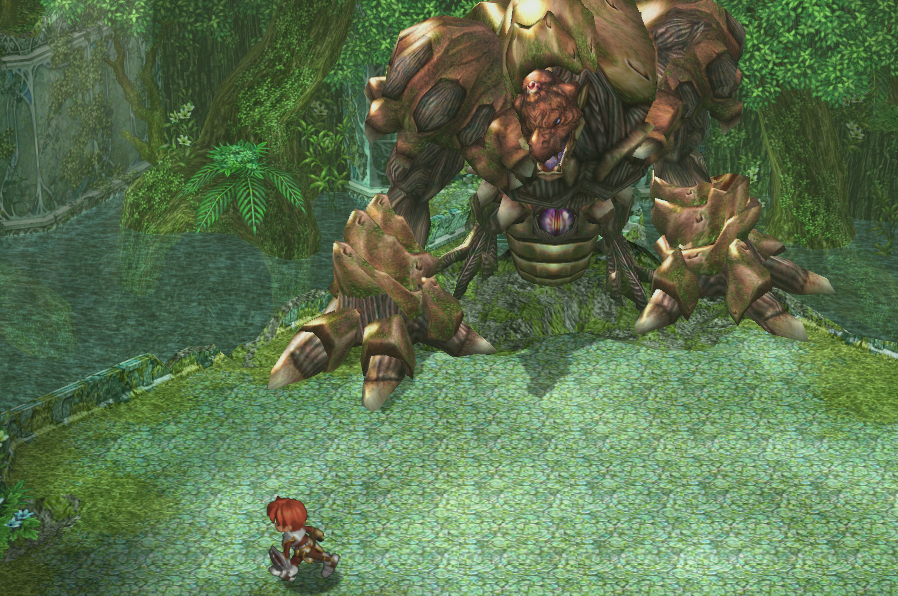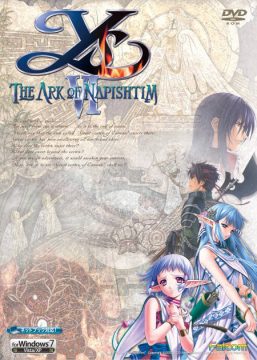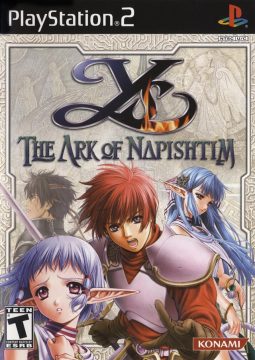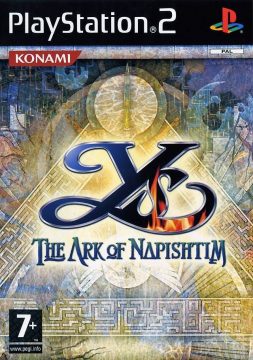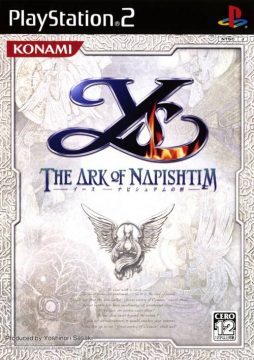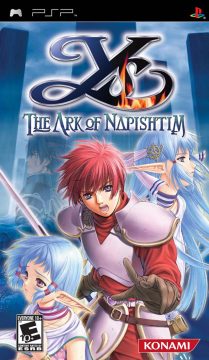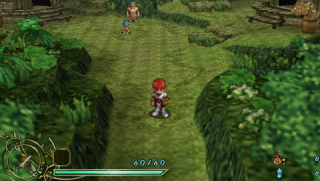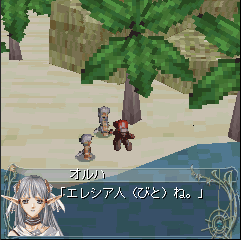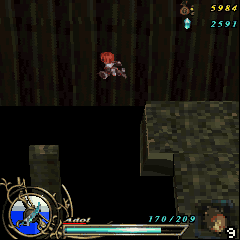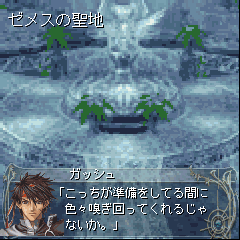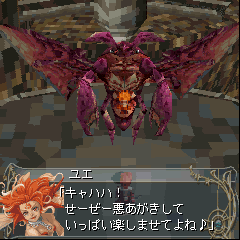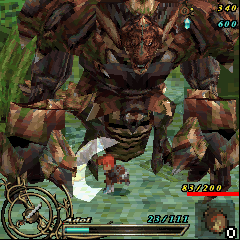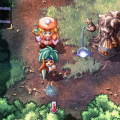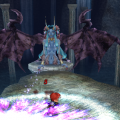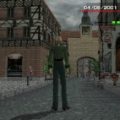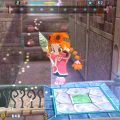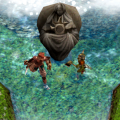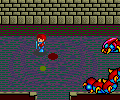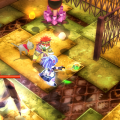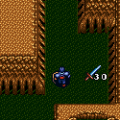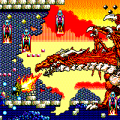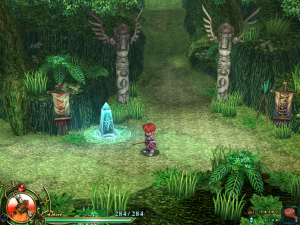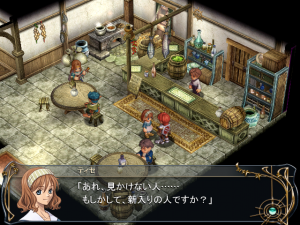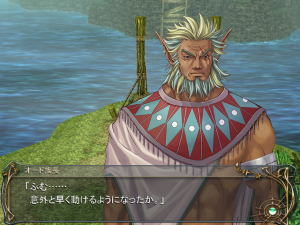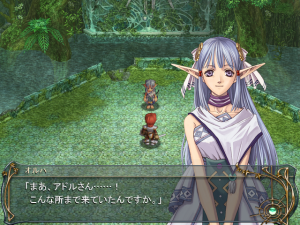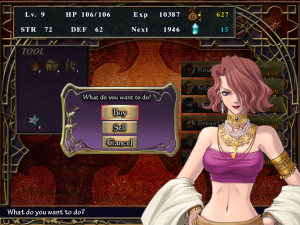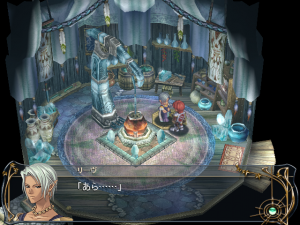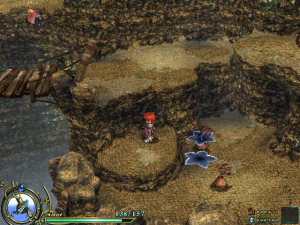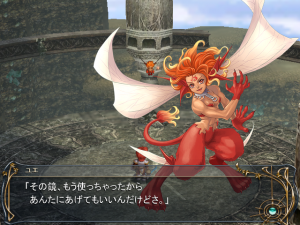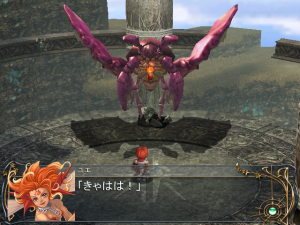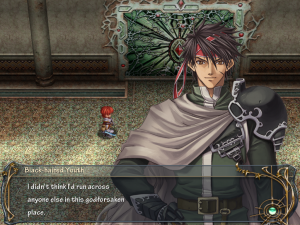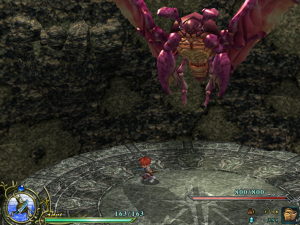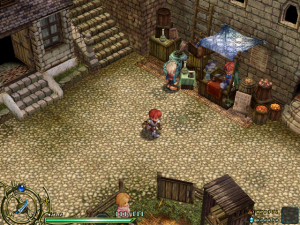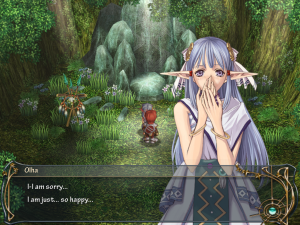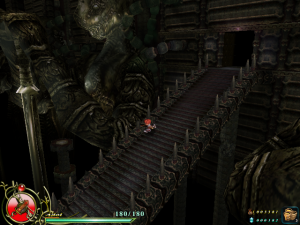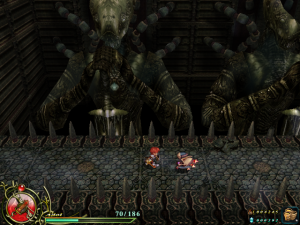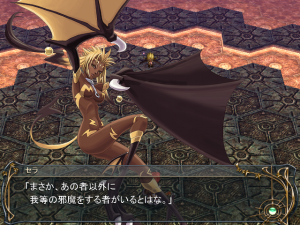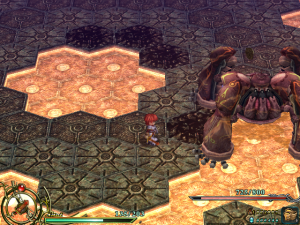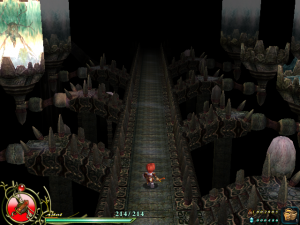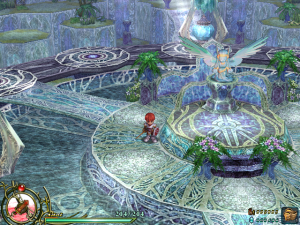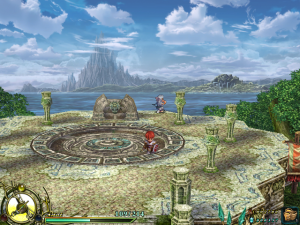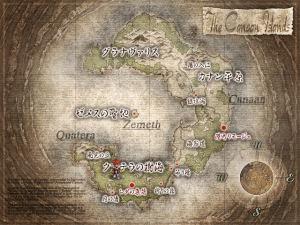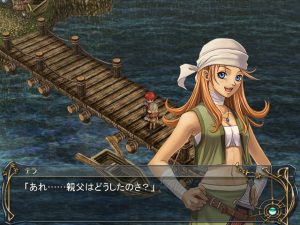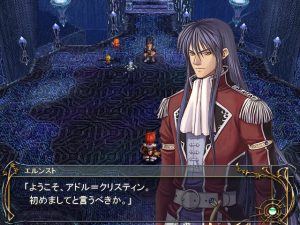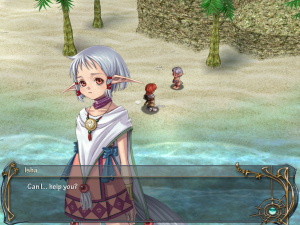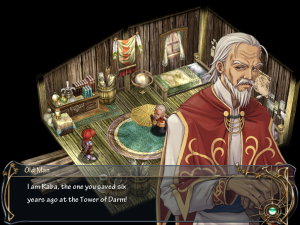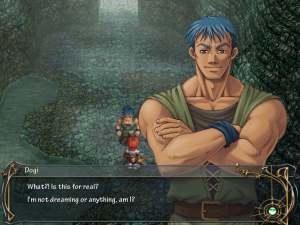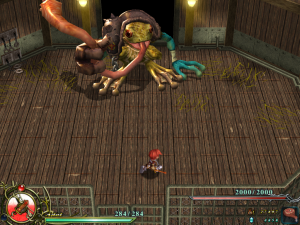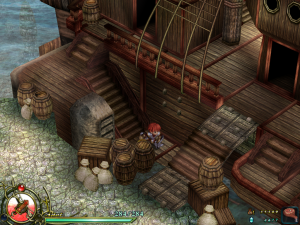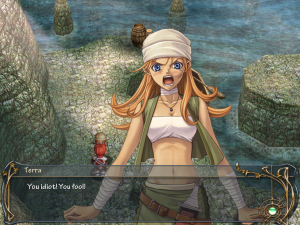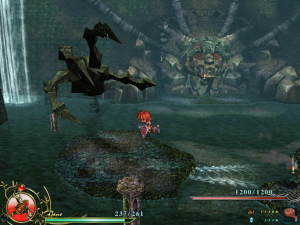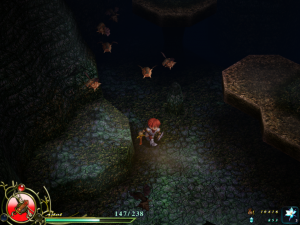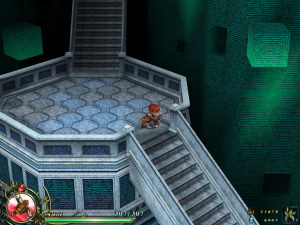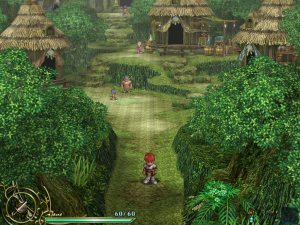- Ys Book I & II
- Ys III: Wanderers from Ys
- Ys IV: Dawn of Ys / Mask of the Sun
- Ys V: Ushinawareta Suna no Miyako Kefin
- Ys VI: The Ark of Napishtim
- Ys: The Oath in Felghana
- Ys Origin
- Ys Seven
- Ys: Memories of Celceta
- Ys VIII: Lacrimosa of Dana
- Lacrimosa of Dana (Novel)
- Ys IX: Monstrum Nox
- Ys Strategy
- Ys: The Call of Solum
- Ys vs. Sora no Kiseki: Alternative Saga
- Ys (Anime)
After the release of Ys V, Falcom slowed down on original game production. Much of their time seemed to be spent porting and upgrading their games to Windows platforms, but they released very few original titles. Finally in 2003, over seven years since the last title in their seminal series, Falcom published Ys VI: The Ark of Napishtim.
The game begins with Adol, setting off on new adventures onboard a pirate ship, ends up being knocked overboard by a ferocious storm. He awakens on a series of islands in the middle of the Canaan Vortex, sort of the Ys analogue to the Bermuda Triangle. The tropical climate is inhabited by a native tribe known as the Rehda, who are based off Native Americans, but with elvish features, like large ears. However, the other side of the island is home to a colony of humans, all of whom, like Adol, have been captured by the vortex. Tensions are high between the two villages, mostly because the human settlement insists on destroying the Rehda ruins in order to build their town. The story doesn’t really begin until the invasion of the Romun army, who are seeking another mythical artifact: the eponymous Ark of Napishtim, which has the power to control the weather.
Characters
Olha
The Priestess of the Rehda clan, Olha is a hunter that finds Adol washed ashore, and believes him in, despite everyone in the village not trusting his non-elven face.
Isha
Olha’s little sister. Initially she is scared of Adol, but after he saves her from the first boss, she comes to look to him as a big brother. She also has visions of his fierce battles, and worries endlessly.
Terra
The little girl from Ys V has grown up, and has graduated from a thief to a pirate. In spite of her younger age, she seems to harbor a crush on Adol.
Geis
Not quite a bad guy but not quite a good guy, Geis is a mercenary that also has a reputation for being an incredible swordsman. He doesn’t look kindly on Adol, but their quests may be the same.
Baslam
A merchant from the land of Altago, which Adol visits in Ys 7. He’s the founder of Port Rimorge, the village of the humans.
Urd
The chief of the Rehdan village, Urd has his doubts about Adol, due to his distrust with the humans on the other part of the islands, but soon approves of his aid.
Ladoc
A great pirate captain, Adol is sailing with Ladoc before being swept up into his adventures. He later makes it, along with Dogi, Tera and the rest of his crew to rescue Adol from the Canaan Vortex and fend off the Romun.
Admiral Agares
An admiral in the Romun army, Agares invades the Canaan Vortex in hopes of finding the Ark of Napishtim.
Ys VI is a natural evolution of the mechanics introduced in Ys V. Adol can still jump and swing his sword with a button press, but in contrast to the stiff controls that plagued that game, the fast-paced action is much closer to the older Ys titles. In addition to combo strings, Adol also has a downward stab, useful for overcoming enemy defenses.
The backgrounds are 3D, while the characters are 2D, with sprites similar to Ys Eternal, though larger and more detailed. However, the camera is controlled automatically and sits comfortably overhead most of the time, but occasionally pans out to show some of the incredible architecture of certain areas. From a technical standpoint, most of the game isn’t particularly impressive, as the level geometry is rather simple and the textures are rather repetitive, but art design quality is so high quality that it’s never an issue. The character artwork is decent, and there’s quite a lot of it too – all of the NPCs (save for the generic Romun soldiers) have both unique names and character portraits, even the ones that barely have any dialogue.
There are a number of subquests, including many optional subbosses. These unlock additional equipment, amongst other niceties. Ys VI also introduces another cutesy animal into the Ys lore: the pikkard, an adorable looking pig-like creature, which makes up for the absence of Roos. One particularly length subquest involves corralling these animals from across the game world.
Some minor elements have deviated from the formula. You can no longer save anywhere, instead requiring that you visit specific monuments to record progress. You can’t heal by standing still either, although visiting the monuments will max at your health. (There is, however, a late game item obtained in an optional subquest that will regenerate HP in the same fashion as older games, and it even works in dungeons.) To make up for this, enemies drop a variety of curatives, including herbs, meat and potions. These can even be used in boss battles, although you can only carry nine of each (and can’t switch mid-fight), so you can’t just stockpile healing items and expect to win.
You still obtain armor and shields in the same manner as the old games, with each new piece possessing greater defensive capabilities. However, there are only three swords, and you use them all throughout most of the game. Similarly to Ys IV: Mask of the Sun, each is affiliated with a different element – fire, wind and lightning – with slightly different slashing styles and magic abilities. Defeated enemies will drop crystals called Emel, which can be used to upgrade the sword of your choice, upgrading their attack power and magic abilities. Unfortunately, the regeneration of magic strength is so slow that they don’t end up being terribly useful, at least until late in the game.
The boss battles are fantastic. The previous Ys games had some great designs but the general clumsiness of the bump system tended to make them more frustrating than fun, but that’s no longer a problem with Ys VI. The foes are often massive, and unlike the rest of the enemies, are built entirely with polygons. They’re easily the most visually impressive aspect of the game. One battle takes place on a stone block that it hurtling towards the ground, as you face off against an enormous giant flying moth. It drops eggs on the ground, which you need to quickly knock off the edge, lest they hatch and cause even more problems. Another is a face of a statue that pounds the ground with two gigantic arms. His weak spot is unreachable by standard attacks so you need to reflect back the exploding projectiles he fires at you. Then there’s the frog who attacks by swinging around his gigantic tongue like a mace.
It doesn’t hurt that the boss battle music is spectacular blazing guitar-driven rock ballad with a vaguely Egyptian influence. The soundtrack, as typical for an Ys game, is exemplary. While it’s still all synthesized, much of the music combines elements of techno, drum and bass, and the usual RPG world music, along with the aforementioned guitar rocking ballad, to create an amazing collection of music. It’s not quite as consistently awesome as some of the other games, as some of the tracks are a bit bland, but what’s good is really good.
For as much as Ys VI does right, there are some rather annoying quirks. Although the game world isn’t all that large, there’s a lot of backtracking required, in some cases having to completely run through already completed dungeons. While there is an item that lets you escape a dungeon anytime you want, it really needs some kind of quick transport ability to cut down on the tedium, especially when you need to go back into a dungeon.
There’s more platforming in Ys VI than the previous game, and while the controls are much better, they’re still occasionally a little slippery. Falling down a bit won’t kill you or even cause any damage, but it will drop you a different part of the stage that you need to escape from. There’s also a maneuver called the dash jump, which lets Adol jump farther, but it’s incredibly difficult to pull off consistently though. It’s never required to beat the game, but many extra items are out of reach until you can master this.
Additionally, there are certain enemies whose attack frames are difficult to discern, and in some cases, are nearly impossible to dodge. In cases, the only real way to beat them is by leveling up and overpowering them, which doesn’t technically make it any worse than the old games, but it feels like a sloppy workaround. Parts of the game don’t feel entirely well balanced either. As a whole, the quest is roughly the same length as Ys IV, but an inordinate amount of time is spent navigating the Limewater Cave, an expansive maze which is mostly clad in darkness, and filled with enemies that do tremendous damage, even when you’re properly leveled up. Most of these quirks become more apparent if you’ve played the immediate follow-ups, Oath in Felghana and Ys Origin, which fixes nearly all of these issues, which makes Ark of Napishtim seem retroactively unpolished by comparisons.
In spite of these occasionally frustrating bits, Ys VI is about the best of a modernization that one could hope for, taking all of the best bits of the old games – the action, the graphics, the visuals – and refining them into an incredibly solid package.
After the initial release of Ys VI, Falcom published a followup edition which includes additional difficulty levels and a time attack. Unlike some of their other games, these were never patched back into the first version. All Japanese versions of Ys VI have issues running on modern Windows platforms, but patches available on Falcom’s site will allow them to work.
In 2005, over a year after its release on the computer, Konami ported Ys VI to the PlayStation 2, dropping the numeral and merely calling it Ys: The Ark of Napishtim. The framerate isn’t as smooth – it caps at 30 FPS – but it still runs fairly well. The graphics obviously aren’t as sharp, something which is especially evident in the pixellated character portraits, but the more impressive areas still look pretty decent.
Konami did make some changes, however. All of the character sprites have been turned into 3D models. They’re better animated, plus Adol’s look changes to match his equipment. But, since they’re more realistically proportioned than the super deformed sprites of the PC game, they look a little unusual in comparisons. The violence has been toned down a bit, as creatures no longer explode into a mess of limbs and blood when they’re killed, but it’s nothing major.
Every single character is now voiced, although the acting is subpar, with characters full of strange accents and speech impediments. Both English and Japanese voice acting is included in the North American and Japanese releases, but neither are very good. Initially Konami was also going to replace the music completely different, orchestral soundtrack, a decision they backpedaled on after fans voiced their displeasure.
However, one can still hear the new music in a new set of subquests called Alma’s Trials, created specifically for the PS2 version. Here you are greeted by a scantily clad fairy named Crevia, also new to the game. While it’s nice Konami tried to add some extra stuff, the trials aren’t very fun. All there is to be found are annoying puzzles, obnoxious platforming challenges that require the use of the infernal dash jump ability, and recycled minibosses. Still, it makes gaining levels easier when the time for the final dungeon comes. The nicest addition is the ability to warp between save points, which eliminates much of the tedium of the original PC version.
Also new are some CG scenes, the most prominent being the opening. While it gives a little backstory that wasn’t in the PC game, the character models look really funky. This is particular true when you see Isha and Olha, as they tried to make anime stylized characters look human. The anime opening found in the PC version can also be activated with a cheat code, but only in the North American and Japanese release, and were altered for the European release.
The PSP version is based on the original PC game, so there’s none of the extra material, but it goes back to using sprites. While it’s faithful to its source material, the port itself is substandard. There’s a significant amount of loading times, sometimes pausing for several seconds during various events, like leveling up. The camera is also far too zoomed in, making it feel somewhat claustrophobic. The sound quality is degraded and the action can be quite choppy. It’s playable, but it feels extremely rough around the edges. It does feature some exclusive extras, like a library where you can unlock profiles of all of the characters, plus an extra dungeon called the Sealed Caves which has a few timed platforming and battle trials, different from the ones in the PS2 game.
In 2008, an English fan translation for the Windows version was released, though the translation is different from the one by Konami.
In 2015, XSeed released an official localization of Ys VI, again with a completely new translation. In addition to getting it to work smoothly with modern operating systems and adding widescreen functionality, it includes a rebalanced “Catastrophe” mode, which eliminates the use of stockable healing items (except for the status curatives), like in the later Ys: Oath in Felghana and Ys Origin. Instead, the item store now sells (extremely expensive) items that will permanently upgrade various stats. This option can be combined with any difficulty level. This version also includes the ability to warp between save points, like in the PlayStation 2 version.
Screenshot Comparisons
PlayStation 2 Intro Screens
Mobile Screenshots
